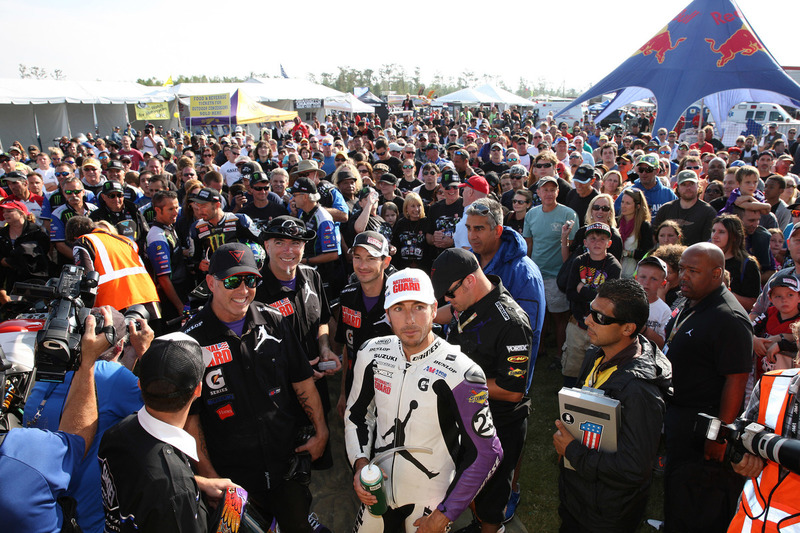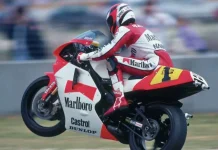FIRST PERSON /OPINION: I monitor online forums and reader comments on the Roadracingworld.com Facebook page regularly, and throughout the 2012-2013 off-season I’ve found fans of professional motorcycle road racing in America bashing the sport they say they love relentlessly and recklessly. Sometimes the comments are accurate and even offer constructive criticism. But more often the comments are way off and based upon erroneous and outdated information, if they are rooted in reality at all. And this poisoning of the well, if you will, affects other fans and potential fans, creating the biggest problem the sport currently faces. I occasionally try to bring a bit of fact and perspective to these discussions in hopes of minimizing the damage, but time and space are always too short. Plus, I find myself writing the same things over and over again. So I figured the time had come to sit down and write an editorial addressing the current state of professional motorcycle road racing in America and what you, the fans can do to help it. One of the popular complaints is that it is wrong and unfair that deserving professional riders, like Tommy Hayden and Jake Zemke, are left without rides in AMA Pro Road Racing, that self-sponsored riders should not be allowed to race with top teams, and that there are too few participants in the sport, in AMA Pro and at the club level. All of these situations — and several more — are the result of the overall economic conditions in the U.S. and the state of the motorcycle industry in the U.S. more than anything else. Even though America has technically been out of a recession for some time now, the motorcycle industry isn’t feeling it yet. At last check, new streetbike and off-road motorcycle sales are still down about 60% industry-wide compared to where they were in 2007 and 2008. That’s a drop from selling over one million motorcycles per year to a bit more than 400,000 units per year. Just to make the math simple, let’s use $10,000 as the average price of a new motorcycle, which means that 60% hit in sales equates to a decline of $6 billion in revenue, every year, just in America! I guarantee you that if you put $6 billion back in the motorcycle industry all of the problems the sport of professional road racing currently faces will suddenly become a whole lot smaller. There will be a lot more manufacturer support for road racing, more sponsorship from the motorcycle aftermarket industry, more professional race teams offering paid rides, more contingency money, bigger purses, and more riders aspiring to get that sponsorship, contingency, purse and those rides, which will boost participation numbers from the Pros down to club racing. Any conversation on the current state of professional motorcycle racing in this country should begin and end with the current economic conditions, and if it doesn’t then that conversation is missing the single biggest factor. Many complaints from fans target DMG (Daytona Motorsports Group), the rights holders of AMA Pro Racing, and how they are operating and overseeing professional racing. Some specific complaints I often see say DMG is not spending enough money and is not doing a good enough job of promoting the sport and that some rich guy with a love of motorcycles should come along, take over AMA Pro Racing, invest in it and take the sport where it should be. Well, for starters, motorcycle road racing is never going to be where we all think it should be. We love it, live it, breathe it, dream it, but it is never going to challenge stick-and-ball team sports for air time on ESPN’s Sports Center or auto racing for overall popularity. We are a very small minority. Tomorrow morning when you go to work or school, compare the number of streetbikes you see to the number of cars, and then remember that every motorcyclist you see is not a fan of road racing. That’s a small indication of where we stand. I point this all out because it’s important for us to have realistic expectations. As for DMG’s involvement in the sport…if DMG had not spent millions to buy AMA Pro Racing when it did, AMA Pro Racing likely would have bled its parent company, the American Motorcyclist Association (AMA), completely dry and put the 89-year-old organization out of business. Don’t believe me? Back when the motorcycle industry had the $6 billion that it doesn’t have now, AMA Pro Racing rarely broke even and usually lost money over the course of a year and had to get regular cash infusions from AMA. DMG has been putting money into AMA Pro Racing from the time of the purchase and has never stopped even though the organization is struggling to break even, let alone turn a profit for its investors, during these tough times. And to the notion of some billionaire coming in to save the sport he loves with his money? Well, we have him. His name is Jim France, he owns DMG, he’s a billionaire, he loves motorcycles and motorcycle racing, and he is trying to save a sport he loves. As for the overall job AMA Pro Racing is doing under DMG, I see most of the complaints by fans as an example of people remembering the past through rose-colored glasses. Sure, there was a time not long ago when there were more factory-supported teams with big semi-trucks and highly-paid stars racing in front of tens of thousands of fans at 12-14 venues a year. But there was also a time not long ago when AMA Pro Racing events were just a small step above televised club races in terms of operations and organization (not competition). And in saying that, I think I might be offending some club racing organizations I’ve worked closely with in the past. Rules were made with little if any input from stakeholders, the rules were enforced selectively if at all, events rarely ran on time, the timing and scoring system worked just as infrequently, there were rider revolts in public over safety, tracks were not motivated to make safety improvements and there were hardly any soft barriers in use. Things did not get immediately better under DMG’s reign. In fact, they got much worse and some long-gone AMA Pro Racing leaders chased a few of our stars into retirement and alienated some of the motorcycle manufacturers. But after a rocky start with plenty of self-inflicted wounds that some still feel today, AMA Pro Racing’s operational leadership has steered the ship mostly back on course. In my opinion and the opinion of others I trust, AMA Pro Racing in the last three years has become the best it’s been during my 13 years in the paddock in terms of getting stakeholder feedback on rules, enforcing those rules, running an event on schedule, providing reliable and detailed timing and scoring information from the start of the first session of the weekend, dealing with riders in a cooperative and respectful manner, working with promoters and venues to improve safety, and deploying soft barriers (with a tremendous amount of help from the Roadracing World Action Fund and its donors) and other safety measures like the new warning light system. Expanding on that, new AMA Pro Racing staff brought over from the four-wheel world by DMG were directly responsible for huge leaps forward in terms of technology, like the live timing and scoring provided via the internet and mobile device applications, live webcasts from press conferences and selected tests, and live streaming online video of practice and qualifying from Daytona. But unfortunately all of this stuff goes largely unnoticed and unappreciated by the fans, especially fans who do not actually attend races in person and who only get their information from online forums. One common complaint these days is the 2013 AMA Pro Road Racing schedule, which I don’t think anyone likes very much or would call good. The series has had big gaps between Daytona and Round Two in the past, but the current 10-week gap is excessive. And the fact that AMA Pro Racing left a To Be Confirmed second round on its schedule until just days before it theoretically could have happened and then cancelled it without any explanation only made the situation worse. That was ridiculous. Now eight events, plus the doubleheader round for Harley-Davidsons to be held in conjunction with the Red Bull Indianapolis Grand Prix, is far from an ideal situation. It’s probably better than forcing cash-strapped teams and racers to endure a 14-event season, but an eight-round season is certainly not great for the fans. Fans who are paying close attention will notice that three of the 2012 events missing from the 2013 schedule – Road Atlanta, Homestead-Miami Speedway and NOLA Motorsports Park – were all events organized by M1 PowerSports, and there are currently no M1-promoted events on the 2012 schedule. Why? That’s a good question that remains officially unanswered. Knowledgeable sources say the rich investor who made it possible for M1 to go from normally promoting one awesome event per year to promoting three events in 2012 — and doing them all bigger and better than before — has suddenly breached their contract and cut off funding, leaving M1 holding the bag. M1, meanwhile, is keeping quiet on the matter in hopes the investor may reconsider once the new TV broadcast deal is done (More on that in a minute.) and they can still promote a race before the 2013 season is over. Another noticeable absence on the 2013 schedule is an event at Sonoma Raceway, formerly Infineon Raceway, formerly Sears Point Raceway, an annual stop on the AMA Pro Road Racing series since 1993 and a track that has hosted AMA Nationals as far back as the 1960s. This is a result of economic factors, Track President and GM Steve Page told me in an interview. Without a headline sponsor as insurance for the bottom line, the track just could not justify taking the financial risk based upon the attendance at its recent AMA Pro races. Some fans want to blame this situation on AMA Pro Racing and an inability to draw more fans, but if Sonoma Raceway could get Great Clips or Kawasaki back as a sponsor the event would be on the schedule with its current spectator attendance. In this economy it’s tough to get companies to spend money on things like motorsports and event sponsorships. As for the new AMA Pro Racing television package, the announcement of which keeps getting put off again and again, it is a real shame that it has taken this long to make it happen. It seems like it should have been wrapped up and finalized by the end of the 2012 season at the latest. I’ve never been privy to the details of these deals in the past and I’m not exactly sure how the flow of money goes, but money is certainly a key element to the deal. Detailing all of the elements, fine points and relationships in a multi-party TV deal is without doubt a time consuming undertaking, but I’m sure if sponsors were standing in line to buy commercial time for the broadcast things would have been a little bit easier and quicker to sort out by now. I keep getting confident reports on the status of the TV deal and alerts that it will be announced any day, but so far all of those alerts have been false alarms. So instead of bashing people for being late to announce the deal, I’m hoping that when the deal–a long-term deal–is announced we will all see that it was worth the wait. With all of this talk about money it’s important to point out that all of the people I know who are working in the sport of professional motorcycle road racing do so primarily because they love it, not because they are getting rich for doing what they are doing. And these people, whether they be racetrack operators, M1 PowerSports, AMA Pro Racing, industry sponsors, race team owners, officials, racers and racing magazine publishers, they are all doing the best job they can with the resources that they have available without going out of business completely. And when you’re working that hard to keep your sport alive, it is very hard to constantly see fans bashing the very sport they say they love. Expressing a well thought out opinion is fine and a right I will fight for, but spreading discontent and misinformation does no good for anyone. So what can you, the road racing fan do to make a difference? For starters, if you’re bashing the sport, please stop. Passion drives our sport as much as anything, and if that passion dies it could dig a hole that goes deeper than the hole the recession dug and set us back years. Instead, why not tell your friends and family why you love this sport? Then once you get them interested, talk them into coming out to see a race or invite them over to watch a race on TV at your house. This will help sustain the sport and possibly create a new fan. If you can’t do that maybe take them out to the garage and just show them your motorcycle. Tell them why motorcycles are cool, how they provide fun and economical transportation and turn them into one of us, because nothing is going to fix our sport faster than for motorcycle sales levels to go back to where they were before the recession. We may never get that $6 billion back into our industry, but I sure would like to see what we could make of professional motorcycle road racing now if we got a little of it back.
Editorial: The Biggest Threat To Professional Road Racing In America
Editorial: The Biggest Threat To Professional Road Racing In America
© 2013, Roadracing World Publishing, Inc.






